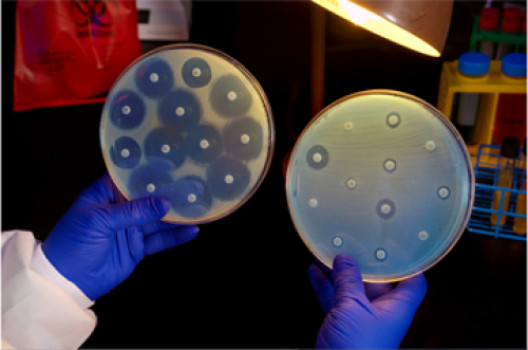
Penicillin, the wonder drug discovered in 1928, works in ways that are still mysterious almost a century later. One of the oldest and most widely used antibiotics, it attacks enzymes that build the bacterial cell wall, a mesh that surrounds the bacterial membrane and gives the cells their integrity and shape. Once that wall is breached, bacteria die — allowing us to recover from infection.
That would be the end of the story, if resistance to penicillin and other antibiotics hadn’t emerged over recent decades as a serious threat to human health. While scientists continue to search for new antibiotics, they still don’t understand very much about how the old ones work.
Now Thomas Bernhardt, associate professor of microbiology and immunobiology at Harvard Medical School, and his colleagues have added another chapter to the story.
Their findings, published Dec. 4 in Cell, reveal how penicillin deals bacteria a devastating blow — which may lead to new ways to thwart drug resistance.
Looking beyond penicillin’s known targets in the cell wall, he and his team have shown that these drugs do more than simply block cell-wall assembly. Penicillin and its variants also set in motion a toxic malfunctioning of the cell’s wall-building machinery, which dooms the cell to a futile cycle of building and then immediately destroying that wall. This downstream death spiral depletes cells of the resources they need to survive.
“It seems to be a common theme with some of the best antibiotics that we have: They don’t just inhibit the enzyme they are targeting; they actually convert that target so that whatever activity it has left becomes toxic,” Bernhardt said. “I think it’s important in understanding how the drug works, but it also teaches us fundamentally about how bacteria build a wall so we can find news way we might throw a wrench in that process.”
Penicillin and similar drugs — a class called beta-lactams — are derived from natural antibiotics produced by fungi that evolved effective ways to kill bacteria. The drugs prevent the bacteria from properly building their cell walls.
There are two parts to the wall-assembly process: synthesizing new strands of linked sugars and then linking them into the expanding matrix. Beta-lactam drugs work by blocking the enzymes that build cross-links, weakening the wall. The wall can’t hold together, so the bacterial cell bursts and dies.
This general framework of the bacteria-penicillin battle is well known, but the molecular details were missing. What happens after blockage of the cross-linking process to promote the death of the bacterial cell?
To find out, Bernhardt and Hongbaek Cho, a postdoctoral fellow in the Bernhardt Lab and lead author of the Cell paper, used a specific derivative of penicillin that targets only one enzyme in cell-wall assembly. Their trick was to genetically manipulate their study subject E. coli to make this enzyme dispensable for the life of the cell.
To their surprise, the scientists saw that targeting the nonessential enzyme with the penicillin still killed the cell. This finding was quite a conundrum. The enzyme could be removed from cells completely without harm. Yet, when it was present and bound by the drug, the cells would die.
The investigators discovered that the root cause of the problem was that the drug not only inhibited the enzyme, but it also caused it to malfunction in such a way that its activity became toxic. They found that the bacteria still made new cell wall strands, but because linking was blocked, they were immediately degraded, which set up a futile cycle of building up and breaking down the cell wall.
This suggested that while the cell has many molecular machines building the wall, the drugs need to hit only a few of them to drain resources from the rest.
“You inhibit some of the machines and, by going through the futile cycle, they deplete cell resources to inhibit even the ones that haven’t been targeted by the drug yet. Your drug becomes much more potent at that point, rather than just being a simple inhibitor that blocks cell-wall synthesis,” Bernhardt said. “You get more bang for your buck with the drug this way.”
Penicillin is powerful, but it’s still vulnerable to resistance. When the cell walls of bacteria are disintegrating, they fight back with enzymes called beta-lactamases that slice the beta-lactam molecules and keep them from attaching to their targets.
Seeing how penicillins work, the scientists have also learned more about how bacteria turn on their beta-lactamases to resist penicillin. An enzyme called Soluble Lytic Transglycosylase (Slt) has been a suspect in recruiting beta lactamases to the struggle. Now it has been directly shown to cause the futile cycle of building and degrading new cell-wall material, creating the alarm signal the bacterium uses to start the production of beta-lactamases.
Knowing in greater detail just how Slt recruits beta-lactamases may lead to ways to block this form of resistance. Bernhardt has already launched new chemical screens at the medical school’s ICCB-Longwood Screening Facility to look for new antibiotic candidates.
“Now that we know more about beta-lactams being toxic, it gives us a hook to look for new molecules that target the cell wall,” he said. “The more we understand how these processes like cell wall synthesis work in bacteria, the better position we’ll be in to find new ways to disrupt it.”
Story Source:
The above story is based on materials provided by Harvard Medical School. The original article was written by ELIZABETH COONEY. Note: Materials may be edited for content and length.
Journal Reference:
- Hongbaek Cho, Tsuyoshi Uehara, Thomas G. Bernhardt. Beta-Lactam Antibiotics Induce a Lethal Malfunctioning of the Bacterial Cell Wall Synthesis Machinery. Cell, 2014; 159 (6): 1300 DOI: 10.1016/j.cell.2014.11.017
